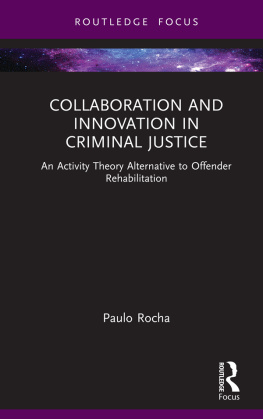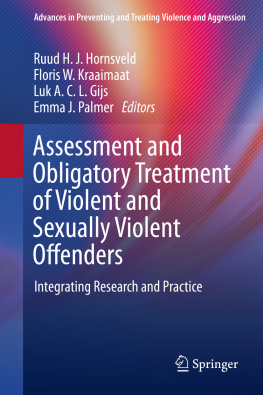Several years back, I learned to be wary of acknowledging any, let alone all, of those who had any contribution to my work. Not because I am ungrateful to them but because I am reticent to compile a list of people who might subsequently be accused of being guilty parties. Although I have been extremely grateful for a vast number of conversations I have had with people across multiple contexts during the research and writing of this book, I would like above all to thank sincerely my friends and family, especially my wife Kasia, my children Filip and Klara and my parents Maria and Hindemburgo. You have supported me throughout this journey, and because of you, everything has had a meaning.
Yet there are more people I will name because a number of ideas present in this book have been best honed by their testing on their brilliant minds. Of all the people from whom I have benefited when discussing the topics of this book, no one has opened my mind more often than Dr. Sarah Hean, Dr. Ann-Karin Holmen, Dr. Reidar Staupe and Stan Sadler. I am happy to credit any of my better observations to them while insisting that any of the worst are mine.
This book was an outcome of a project that received funding from the European Unions Horizon 2020 research and innovation programme under the Marie Skodowska-Curie grant agreement No. 734536. A special thanks to all the staff of the liaison and diversion agency that was part of this study.
Paulo Rocha,
April, 2021
Introduction
DOI: 10.4324/9781003186793-1
1.1Empirical background
Offender rehabilitation is a strategy of paramount importance that the criminal justice system uses to promote the reintegration of individuals into the community (Armstrong & McNeill, 2012; Ministry of Justice UK, 2013). In this vein, motivating offenders to engage in rehabilitative interventions is a key step toward their potential desistance from further criminal behaviour (Fazel & Danesh, 2002; Fazel & Wolf, 2015; World Health Organization, 2005). As inmates are three times more likely to struggle with multiple vulnerabilities (which includes, for example, mental health problems, substance misuse and learning disabilities) than the population in general (Sinha, 2010), commensurate rehabilitation strategies ought to tackle clusters of correlated needs and provide multifaceted solutions (Andrews & Bonta, 2016). To that end, the involvement of professionals from multiple areas of care in the rehabilitation process is pivotal to enhance peoples odds of remaining crime free (Hean et al., 2009; Strype et al., 2014).
Policymakers worldwide strive to produce adequate policies that progress integrated care organised between criminal justice and welfare services (Department i Helse og Omsorg, 2013; Department of Health, 2010; World Health Organization, 2015). When interagency collaboration engenders co-provided care, mental health outcomes improve, reoffending rates decrease and the financial costs incurred by the taxpayers supporting prison and health services drop (Bond & Gittell, 2010). The challenge, however, is that policymakers and service leaders have focused on generic integration strategies that overlook the reality existent at street level, such as the mis-alignment of organisational working schedules, logistical issues and limited resources (Rocha & Holmen, 2020).
This book reflects on a case study was conducted in the context of offender rehabilitation in England and Wales to explore the perspective of front-line workers across criminal justice and welfare systems. The focus of the study was on a public service called Criminal Justice Liaison and Diversion (L&D), an organisation that supports vulnerable offenders when they are first in touch with the criminal justice system (e.g., police custody and court) by diverting them, if appropriate, to health and other care services as early as possible in their trajectory through criminal justice (James, 1999). As such, L&D is a model of funding, administration, organisation, service delivery and care designed to engender connectivity, alignment and collaboration within and between differentiated sectors (Kodner & Spreeuwenberg, 2002).
For over three decades, L&D services have been locally managed (Reed, 1992), which has produced varied results across sites. During this time, however, the national government has recurrently attempted to unify L&D practice over England (James, 1999). In its most recent attempt, the government has commissioned a review to assess the condition of people with mental health problems or learning disabilities in the criminal justice system (Carter, 2007), which resulted in a report (Bradley, 2009) confirming the relevance of L&D services at both police custody and courts to divert vulnerable individuals into care (McGilloway & Donnelly, 2004). Based on the findings of the review, policymakers and service leaders developed a national model for L&D services intending to unify practice across the sites (NHS England Liaison and Diversion Programme, 2014). The document specifies outcomes to be equally achieved nationwide and bases the funding of local services according to their performance. This formula was initially implemented in a few forerunner locations (called wave one sites) in England on April 2014 and has, ever since, been spread across all the sites.
In light of this, this book investigates how interagency collaboration between L&D and neighbouring services has been perceived by street-level L&D workers after the introduction of the new national model for liaison and diversion services. The focus is pointedly on the perspective of front-line workers to explore a different angle regarding models of interagency collaboration across criminal justice and welfare systems, as traditional research is prone to focus on service-level outcomes (Parker et al., 2018). In other words, by investigating the perspective of L&D front-line workers on the role of the service as a bridge between criminal justice and welfare services, this book is an attempt to develop a better understanding as to why interagency collaboration is still challenging to achieve at the street level despite the willingness demonstrated by organisations to work in tandem.
1.2Theoretical background: interagency collaboration in offender rehabilitation
Interagency collaboration has been widely suggested as an appropriate means to address the challenges of vulnerable individuals coming in contact with the criminal justice system by the scientific literature (Department i Helse og Omsorg, 2013; Department of Health, 2010; World Health Organization, 2015). Notwithstanding, readers striving to make sense of the topic might find themselves dumbfounded by the wide range of interchangeable terms loosely adopted to explain the same phenomenon, that is, organisations working in tandem. This creates a conundrum for those attempting to differentiate interorganisational relationships from interagency collaboration. Terms such as interagency, multiagency and multisectoral, for instance, have been used to describe the relationship between different organisations (Statham, 2011; Williams, 2012). Moreover, terms such as cooperation, collaboration, coordination and integration have been adopted to describe the increasing levels of formalisation that such relationship embodies. exemplifies the multiple levels of interagency working.
Increasing levels of formalisation (Frost, 2005)
| Label | Features |
|---|
|
|---|
| Cooperation | Organisations working together, but independently, to achieve consistent goals and provide complementary services |
| Collaboration | Organisations working jointly to address the shared goal of mitigating issues of duplication and/or gaps in service provision |



